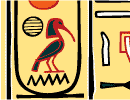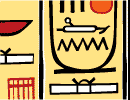|
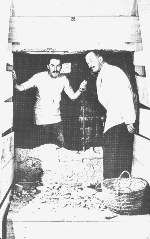
Howard
Carter and his backer Lord Carnavon standing by the wall leading to
the intact burial chamber of King Tut.

Tut's
coffin before the initial unveiling of his mummy.
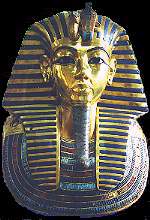
Tut's
Death Mask
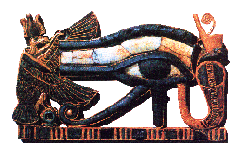
Eye
of Horus
Made
of gold and inlaid lapis, this piece was a pectoral amulet, worn around
the neck.
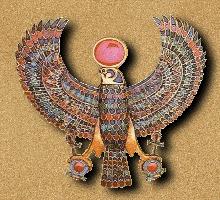
Horus
Here's
one of the forms of horus as seen on another beautiful inlaid pectoral
amulet.
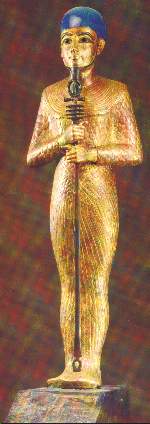
Ptah
This
beautiful gold covered statue of the god Ptah has a blue faience cap
and a gilded bronze scepter.
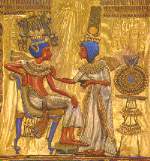
This
is the scene on the throne of King Tut depicting King Tut with his queen
Ankhesenamun.
|
Indeed,
it is his little known status that contributed to the successful hiding
of his tomb, which was covered over by a later pharaoh who was clearing
away an area in which to cut his own tomb.
On
November 26, 1922, Howard Carter made archaeological history by unearthing
the first Egyptian pharaonic tomb that still contained most of its treasures.
Still, even this tomb had been robbed in antiquity, although the the
robbery attempt was apparently thwarted before the thieves could make
away with most of the treasure.
This tomb also yielded something else that had never been found in modern
history - the pristine mummy of an Egyptian king, laying intact in his
original burial furniture.
Thus,
Tut's tomb gives us a unique opportunity to explore the life of King
Tut and allows us to learn more about this essential period in New Kingdom
Egyptian history.
Tut
Links
Here are links to information about
King Tut, available over the Internet. Be sure to check out the actual
entries from Howard Carter's journal which are included for your enjoyment.
Tutankhamen
Enjoy this 75th Anniversary of the discovery of
Tut's tomb through this Tut tribute by the Egyptian State Information
Service.
The
Death of Pharaoh
A concise accounting of the life and death of
King Tut including some history about the timeframe in which he lived.
The
Diaries of
Howard Carter
Check out this two part installment of the journal of Howard Carter
around the time of his discovery of Tut's tomb.
Part
ONE
October 28 - December 31, 1922
Part
TWO
January 1 - May 31, 1923
|
